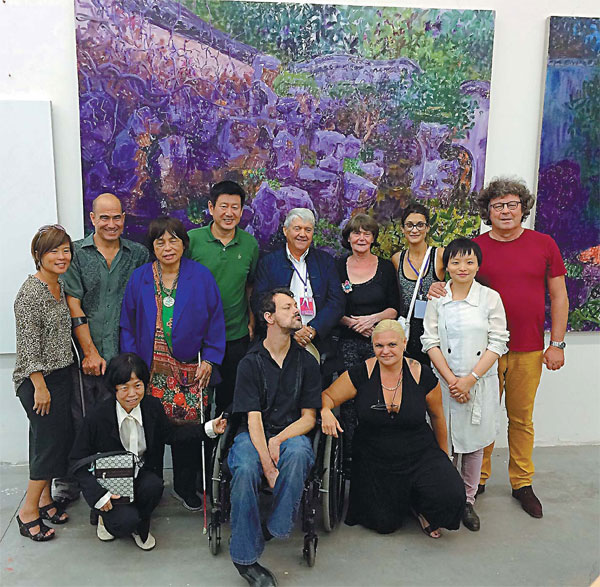Art collectives for disabled help break down taboos
|
A group that includes international artists with disabilities visited a studio in Chengdu, Sichuan province. Provided to China Daily |
French group's show of works by handicapped its first in China
The 5 Colours Foundation, founded in 2009 in Chengdu, Sichuan province, hosted the "Possibility: International Disabled Artists Exhibition" on Sept 18 to showcase the works of five artists with disabilities from the United States, France and Singapore.
The exhibit marked the first showing in China by Creative Handicap, a French collective of disabled and non-disabled artists.
In 2004, Sylvie Sanchez, a non-disabled French sculptor, created Creative Handicap to find new possibilities of approaching art and disability.
"We observed a lack of public understanding about disabled people," Sanchez says. "The aim of Creative Handicap is to open art to everybody. Art then becomes a mediator and breaks down taboos."
In a 150-square-meter space in the Asnieres-sur-Seine suburb of Paris, Creative Handicap hosts workshops, exhibitions, guided tours and training. Sanchez and her partner, Franck Spengler, the son of French writer Regine Deforges, spots and trains talented artists with disabilities, such as Monique Plumecoq and Andre Soler (both are blind), whose works were displayed in the Chengdu exhibit.
The 5 Colours Foundation was established in 2009 by Zhou Chunya in Chengdu, one of the most influential contemporary painters in China, known for his Green Dog and Peach Blossom series of paintings, to help students disabled in the devastating Sichuan earthquake of 2008.
"After the earthquake, 5 Colours Foundation was there to support students disabled in the tragedy, whether in daily life or in the pursuit of art."
The foundation helps disabled students develop artistic skills for potential job opportunities, such as in product design. It believes that art provides psychological rehabilitation and therapy to students disabled in the disaster.
"Art soothes the soul, inspires the creative spirit and also assists with life skills," Zhou says.
The foundation has helped more than 200 young people in Sichuan province and other areas, and many have had their artworks displayed alongside works from other Chinese and international artists.
Both organizations have similar challenges in helping disabled artists. In a workshop following the exhibition, Sanchez reviewed the history of disabled people and art education for the disabled in France and believes there are still practical issues to solve for 15 percent of the French population who are disabled.
Sanchez says many disabled people have difficulties in filling out government forms to receive benefits. There are few guided tours organized for disabled people in museums and other public institutions and it is hard for the mainstream art community to evaluate or recognize the artistic value of disabled artists, she says.
Zhou says 5 Colors Foundation is still learning to adjust as the first art NGO for disabled people in China. It is the foundation's and its donors' aim for the scope of government relief to gradually extend to include China's disabled population.



















